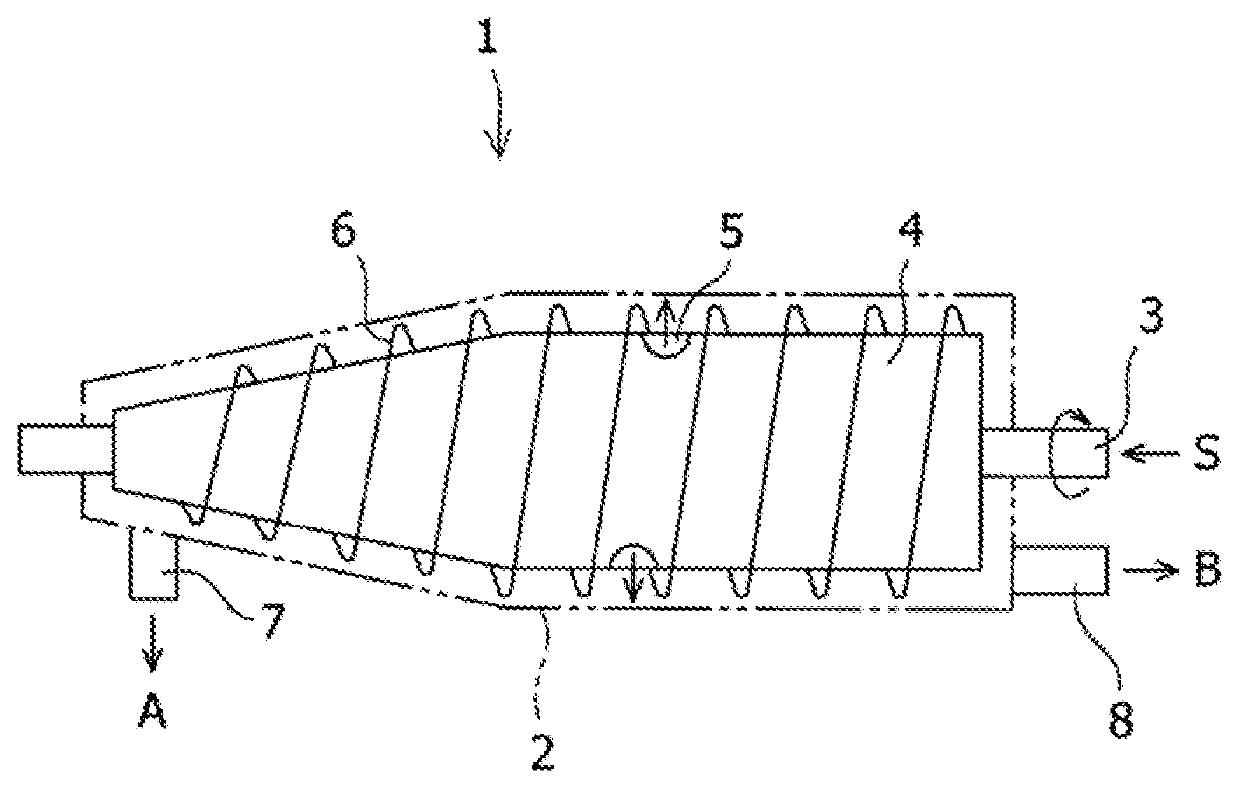Hypromellose phthalate and method for producing hypromellose phthalate
a technology of hypromellose phthalate and hypromellose phthalate, which is applied in the field of hypromellose phthalate and a production method of hypromellose phthalate, can solve the problem that the hpmcp product is likely to have a small particle size, and achieve the effect of stable feeding
- Summary
- Abstract
- Description
- Claims
- Application Information
AI Technical Summary
Benefits of technology
Problems solved by technology
Method used
Image
Examples
example 1
[0055]The 7.0 kg of hydroxypropyl methyl cellulose having a hydroxypropoxy substitution degree per glucose unit of 9.0% by weight and a methoxy substitution degree per glucose unit of 28.9% by weight was added to 11.2 kg of glacial acetic acid in a 50-L kneader with a biaxial mixer, dissolved, then subjected to addition of 5.8 kg of phthalic anhydride, 109 g of sodium chlorate and 3.0 kg of sodium acetate, and reacted at 85° C. for 4.5 hours. The reaction mixture was subjected to addition of 12.9 kg of water and stirred. Then, water in an amount of 21 times the weight of the HPMC was gradually added to the reaction solution to precipitate crude HPMCP. The precipitate was filtered by using a horizontal filter plate type filtration device and washed with water. The obtained HPMCP was mixed with water to obtain a suspension having a temperature of 7° C. and an HPMCP concentration of 6% by weight. The HPMCP suspended particles in the obtained suspension had an average particle size of 5...
example 2
[0063]An HPMCP suspension having a temperature of 7° C., a concentration of 6% by weight and a suspended particle average particle size of 507 μm, was obtained in the same manner as in Example 1. The HPMCP suspension was subjected to liquid removal (solid-liquid separation) by using a centrifugal decanter (decanter type continuous centrifugal separator, type Z18, manufactured by TANABE WILLTEC INC.) at a centrifugal effect 900 G. After the liquid removal, the HPMCP particles had an average particle size of 330 μm and the reduction ratio was 35%. After the liquid removal, the HPMCP cake had a liquid content of 62.8% by weight.
[0064]The HPMCP cake was dried at 80° C. in the same manner as in Example 1. The drying time of the HPMCP cake was 0.91 relative to the drying time of the liquid-removed HPMCP cake in Comparative Example 1 after liquid removal by using a filtration type centrifugal dehydrator. The results are shown in Table 1.
[0065]The dried HPMCP was then sieved through a 10-me...
example 3
[0067]An HPMCP suspension having a temperature of 7° C., a concentration of 6% by weight and a suspended particle average particle size of 971 μm, was obtained in the same manner as in Example 1 except that the washing step of washing a crude HPMCP was not carried out. The HPMCP suspension was subjected to liquid removal (solid-liquid separation) by using a centrifugal decanter (decanter type continuous centrifugal separator, type Z18, manufactured by TANABE WILLTEC INC.) at a centrifugal effect of 2500 G. After the liquid removal, the HPMCP particles had an average particle size of 241 μm and the reduction ratio was 75%. After the liquid removal, the HPMCP cake had a liquid content of 60.1% by weight.
[0068]The HPMCP cake was dried at 80° C. in the same manner as in Example 1. The drying time of the HPMCP cake was 0.77 relative to the drying time of the liquid-removed HPMCP cake in Comparative Example 1 after liquid removal by using a filtration type centrifugal dehydrator. The resu...
PUM
| Property | Measurement | Unit |
|---|---|---|
| particle size | aaaaa | aaaaa |
| particle size | aaaaa | aaaaa |
| particle size | aaaaa | aaaaa |
Abstract
Description
Claims
Application Information
 Login to View More
Login to View More - R&D
- Intellectual Property
- Life Sciences
- Materials
- Tech Scout
- Unparalleled Data Quality
- Higher Quality Content
- 60% Fewer Hallucinations
Browse by: Latest US Patents, China's latest patents, Technical Efficacy Thesaurus, Application Domain, Technology Topic, Popular Technical Reports.
© 2025 PatSnap. All rights reserved.Legal|Privacy policy|Modern Slavery Act Transparency Statement|Sitemap|About US| Contact US: help@patsnap.com

